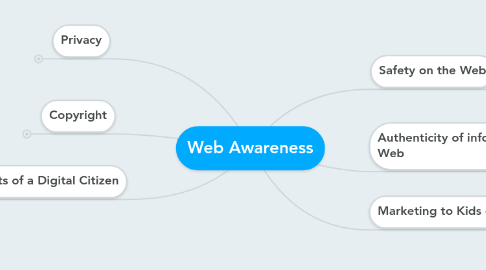Web Awareness
by Eric Harty

1. Copyright
1.1. Copyright laws are in place to help protect the intellectual property of both individuals and publishers of online materials. What these copyright laws help protect is to keep in mind the rights of the owner, and to help control how that property is copied, altered, or sold.
2. The Nine Elements of a Digital Citizen
2.1. 1: Digital Access: The Ability to access online tools and information.
2.2. 2: Digital Commerce: The ability to recognize that much of our economy is regulated online.
2.3. 3: Digital Communication: Understanding that there is a standard of etiquette with all forms of communication platforms found online.
2.4. 4: Digital Literacy: The ability to use online tools.
2.5. 5: Digital Etiquette: Certain mediums demand a higher level of online behaviour than others.
2.6. 6: Digital Law: An understanding that if actions such as Copyright infringement, identity theft, and Cyberbullying occur, they can be punishable by law.
2.7. 7: Digital Rights and Responsabilities: An understanding of our digital rights, such as privacy and speech.
2.8. 8: Digital Health: An understanding that there are stresses and health concerns related to internet usage.
2.9. 9: Digital Security: An understanding that one must protect themselves and their information by backing up data and protecting their identity.
3. Privacy
3.1. Online privacy is perhaps one of the most important issues that has arisen within the past ten years in regards to internet safety. As a digital citizen one must always be aware of the information you are making available to see, as well as any personal and financial information that may be at risk. For example Geo-tagging, which is the process of adding coordinates to a photograph or other form of media, can cause issues of privacy due to the fact that you are giving your location away to a number of different people you may or may not know. This can not only cause issues for adults, but can be extremely problematic for the vulnerable sector.
4. Safety on the Web
4.1. Students need to be aware of their own personal digital footprint they are leaving behind as they both communicate on, and search the internet. Certain issues that one must be aware of when considering online safety is cyberbullying, viewing explicit material, and ethical issues concerning different social media platforms. The best way to both understand and prevent these issues from arising within the classroom is to help student understand what it means to be a digital citizen, and the potential consequences that go along with breaking these rules.
5. Authenticity of information on the Web
5.1. Both students and teachers must be skeptical when reading information found on the internet. When looking through any information we must ask ourselves: Is there an Author? What is the Authors qualifications? Who is the Sponsor? Is the sponsor reputable? One important fact to remember when looking for information on the internet is that anyone can publish anything they want to on the internet and it us up to a Digital citizen to recognize the validity of that content.
6. Marketing to Kids on the Web
6.1. Kids represent a large demographic of consumers within the marketplace whether they are using their own money or not! It is shocking how much kids influence the purchasing habits of their entire families. As digital citizens we must be aware of the impact of marketing that corporations can have on both our students and children, and how that directly effects our purchasing choices. We must also be aware of the marketing techniques used and how the internet can play a large role in our spending tendencies.


